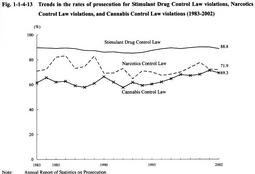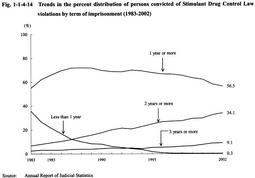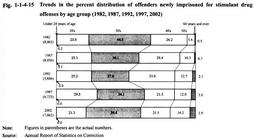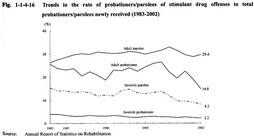| Previous Next Index Image Index Year Selection | |
|
|
3 Treatment of drug offenders (1) Disposition by public prosecutors offices Fig. 1-1-4-13 shows the trends in the rates of prosecution for Stimulant Drug Control Law violations, Narcotics Control Law violations, and Cannabis Control Law violations over the last 20 years. The rate for Stimulant Drug Control Law violations was within the 85-90% range, except for surpassing 90% in 2000 and 2001. The rate for Narcotics Control Law violations was on the rise since 1997, declined moderately in 2001 and 2002, falling to 71.9% in 2002. The rate for Cannabis Control Law violations was generally on the rise since 1995, hit its highest level over the last 20 years in 2001 at 71.4% but then declined slightly to 69.3% in 2002 (see Appendix 1-6 ).
Fig. 1-1-4-13 Trends in the rates of prosecution for Stimulant Drug Control Law violations, Narcotics Control Law violations, and Cannabis Control Law violations (1983-2002) (2) Disposition by courts Fig. 1-1-4-14 shows the trends in the percent distribution of persons sentenced to imprisonment with labor for Stimulant Drug Control Law violations in the ordinary first instance over the last 20 years, by the term of imprisonment. The percentage of those persons sentenced to imprisonment with labor for less than 1 year dropped sharply after reaching 35.7% in 1983, and it has subsequently been below 1% since 1996. In contrast, the percentage of those persons sentenced to imprisonment with labor for 2 years or more but less than 3 years has increased from 6.8% in 1983 to 34.1% in 2002, which indicates that sentences have become gradually heavy.
Fig. 1-1-4-14 Trends in the percent distribution of persons convicted of Stimulant Drug Control Law violations by term of imprisonment (1983-2002) (3) Correction Stimulant Drug Control Law violation is one of the most common types of offense among inmates detained in correctional institutions. All correctional institutions where inmates for Stimulant Drug Control Law violation are detained have special treatment programs for the education of those inmates. Recent such education programs are marked by employing various staff members, not only staff in institutions but also outside professionals.
Fig. 1-1-4-15 shows the trends in the percent distribution of offenders newly imprisoned for Stimulant Drug Control Law violations by age group, in 5-year periods since 1982. The percentage of those aged 30-39 was the largest from 1975 until 1988, and that of those aged 40-49 became the largest thereafter. Recently, however, the percentage of those aged 30-39 has been the largest again. The share of those aged 50-59 or over 60 has increased gradually in line with the aging of the population. Fig. 1-1-4-15 Trends in the percent distribution of offenders newly imprisoned for stimulant drug offenses by age group (1982, 1987, 1992, 1997, 2002) (4) Rehabilitation Probation offices endeavor to improve probation programs for drug offenders, by classifying them into "stimulant drug offenders" and "abusers of thinners, etc." in the system of the categorized treatment (See "Probation" in Part 2, Chapter 5, Section 3 ). The offices also try various treatment practices, such as providing group guidance to probationers/parolees and their guardians and guarantors.
Fig. 1-1-4-16 shows the trends in the rate of drug offenders to all probationers/parolees newly received over the last 20 years. The rate of drug offenders in adult parolees increased moderately since 1983 and then declined after peaking in 1998. In 2002, however, it increased by 0.9 points from the previous year to 29.6%. Fig. 1-1-4-16 Trends in the rate of probationers/parolees of stimulant drug offenses to total probationers/parolees newly received (1983-2002) Explanation of termsMoney laundering: Money laundering refers to the process by which offenders conceal or disguise the origin of proceeds of drug offenses, etc, and make the proceeds look like profits gained from legal commercial transactions, such as, the act of transferring money through a series of bank accounts. Controlled delivery: Controlled delivery refers to an investigative technique that allows specific consignments of illicit drugs to be distributed under close observation without immediate seizure. The objective of controlled delivery is not only to identify the person who received the drug, but also to permit successful clearance of persons involved in the transactions. On the other hand, "clean controlled delivery" refers to an investigative technique that removes illicit drugs which were discovered by the police, etc, but allows a consignment of alternatives substituted for the illicit drugs to be distributed. |



